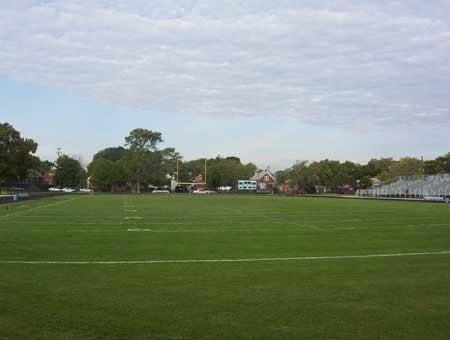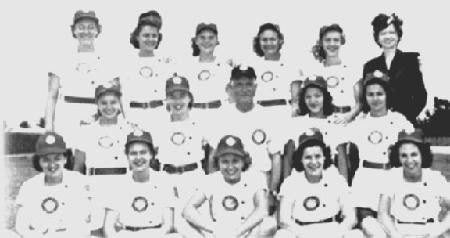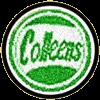Chicago Colleens-Shewbridge Field (Amos A. Stagg Stadium)
Introduction
Text-to-speech Audio
Images
Amos A. Stagg Stadium was built at the location of the Shewbridge Field, once home to the Chicago Colleens

1948 Chicago Colleens team picture

Official logo of the Chicago Colleens

Backstory and Context
Text-to-speech Audio
The All-American Girls
Professional Baseball League (AAGPBL) operated from 1943 to 1954. The
AAGPBL lasted long past 1945, when the end of World War II led to a resumption of
normal life in the United States. The impetus of the league was a way for team
owners to generate revenue-especially teams in small
cities as many minor league teams saw many of their players
leaving baseball during the war years to serve n the military. Despite expectations, the league continued
for nearly a decade after the war owing to the quality of baseball and the
creative talents of league promoters.
The Chicago Colleens were one of the ten teams
listed on the 1948 season AAGPBL roster. They were members of the
Eastern Division and were managed by the former National League professional
player Dave Bancroft aka "Beauty". Unfortunately for Bancroft, the Colleens were one of the worst teams in the
league, finishing with a losing record of 47-76. As a result, the Colleens and the Springfield Sallies (another losing
club) functioned as rookie development teams that traveled around the
country playing each other and other teams in exhibition games. These teams
toured in both 1949 and 1950 and primarily traveled in the South and East areas
of the United States. Many official lists ignore both teams after
1948, but their existence in the league remained until 1950.4
These exhibition teams were used as a way to
market the AAGPBL beyond the upper Midwest where most AAGPBL teams were located. These teams were used not just to train new rookie
recruits and give them experience in the league, but to show other areas of
the United States that women were in fact playing baseball. Like other
AAGPBL teams, the athletes were expected to play well, but also present themselves as
"proper women," - they all attended charm school and followed strict rules of etiquette.1
Fran Janssen stated in her interview with Jim
Sargent, ”We traveled more than 10,000 miles in 1949 from Illinois to Texas,
across the Gulf states and up to New Jersey and Pennsylvania. We played in
minor league parks in Tulsa and Baltimore, as well as in city parks, and we
drew good crowds.. We rarely spent more than two nights in a town. We had to
make fast trips." Fran estimated that the team played in about fifty cities from New York to Florida and throughout Midwest and Southern states
in their first year as a traveling team.
Former player Patricia L Brown commented in her
book, "A League of My Own," that by 1950, the team played more than
100 games in the U.S. in Canada, playing in a range of fields from poorly
managed recreational fields to minor league parks.
The team was managed by Major League Hall of Fame
shortstop, Dave Bancroft. From 1924 to 1927 Bancroft managed the
Braves but only managed a 249-363 record before losing his job. He found work once again as a player-manager for the next few years before becoming a
full-time manager for minor league teams such as
the Minneapolis Millers of the American Association (1933), his
hometown Sioux City Cowboys (1936), and the St. Cloud Rox (1947). The
following year he became the manager of the Colleens. 5
Although many attribute the end of the war as the reason
for the league's demise, the attendance peak occurred after the war's end; the
league's ten teams collectively drew 910,000 fans in 1948. Thus,
there existed an appreciation of women's baseball that went beyond
"filling the void of men leaving for war." The league ended in
1954 due to many factors, such as decentralization of the league and
a recession that prevented money being spent for promotion. 6
After the Colleens left, the field was used
for serious sporting functions. Today, Shewbridge Field is known Amos Alonzo Stagg
Stadium, named for the famous University of Chicago football coach. Stagg
played football at Yale before coaching in Massachusetts at an institution
that grew into Springfield College. James Naismith was mentored by
coach Stagg, and would go on to become the inventor of basketball. In
1892, Stagg was hired by the University of Chicago to develop courses
in physical education and also develop the university's football
team.
Although the University of Chicago later discontinued its football team in order to concentrate their
resources on academics, Stagg built the University of Chicago into one of
the greatest football powerhouses
in the first decades of the 20th century. Stagg complied a record of 242-112-27 while at the University of
Chicago and led the Maroons to seven Big Ten Conference championships.
During these years, Stagg developed many features of the game that increased
its popularity among fans, such as the lateral pass and the reverse. He also
created tackling dummies so that players could perfect their technique without
suffering as many injuries. Stagg's influence on the game of football was so
significant that Notre Dame coach Knute Rockne once claimed
that "all football comes from Stagg."
